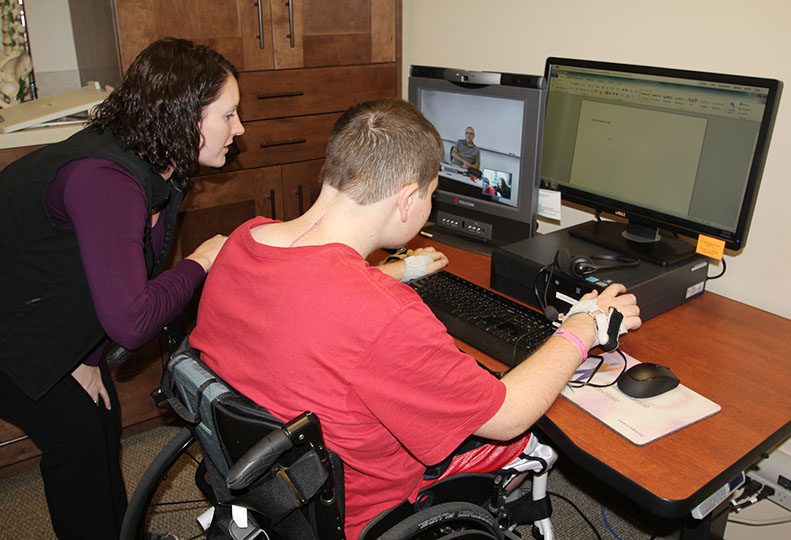
Home » St. Luke's new space goes tech driven
St. Luke's new space goes tech driven
Hospital opens new lab, separate model apartment employing assistive devices

October 24, 2013
Video-conferencing technology in a new lab at St. Luke's Rehabilitation Center has enabled a 15-year-old recovering from a spinal cord injury at the hospital here to interact daily with his algebra class in Genesee, Idaho, about 100 miles south of Spokane.
Grayson Esser, who had been rehabilitating at St. Luke's since an ATV accident in July, says the assistive technology lab also helped him learn technology for daily tasks, such as writing, through a voice-to-text software program. He'll later use the writing software on a laptop.
Esser, who uses a wheelchair, was one of the first patients to use the lab, which St. Luke's opened in July. He says he can move triceps muscles in his arms, but he has limited dexterity in his fingers.
"I stay here to do rehab, but my school is still going on," adds Esser, who is a sophomore. "I've been able to keep up with my classes and not fall behind. I can do math every day. My teacher has a camera in the classroom, so they can see me, and I can see them."
Learning to use such technology-assisted connections plays a role in the health and recovery of patients by lowering stress and social isolation while patients are in the rehabilitation hospital, says Nicole Stewart, spokeswoman for Inland Northwest Health Services, which operates St. Luke's.
Around the corner from the lab, St. Luke's also recently opened a nearly 600-square-foot space remodeled to resemble an apartment, where patients recovering from a stroke or who have limited mobility because of a disability can work on improving independent-living skills. The apartment space also includes an automated environmental-control system that can be activated by an iPad or other devices.
Stewart says the cost of both projects at St. Luke's totaled $120,000, which was funded in part by grants and donations from the Christopher and Dana Reeve Foundation, tw telecom Inc., and individual donors.
St. Luke's 275-square-foot assistive technology lab includes five learning stations, each installed with computers, software, and equipment. An iPad also is available.
The lab includes the video-conferencing equipment, voice-to-text technology, and a driving-simulator station connected to a computer. The space also has a 55-inch, flat-screen TV, which can display material from one of the computers and is used if someone has limited vision or to display educational videos.
Additionally, the lab is stocked with specialized equipment that includes enlarged computer screens to help people who have limited vision, and computer keyboards that are wireless and can be placed on a lap or wheelchair tray for easier access.
Different types of adaptive computer mouse devices also are available depending on patients' needs, including a control device with a large rollerball on the top to control movement and that is used by people who have impaired hand movements.
Patients with severe paralysis also can use in the lab what is called a computer mouth stick, which is held in the mouth by a person with a disability to manipulate a computer screen or keyboard.
Meanwhile, the new apartment unit that is available to patients for practicing independent living skills has a small kitchen, living room, and bedroom, as well as the automated environmental-control system to control the lights, window shades, and TV.
The environmental controls can be activated by someone using an iPad or a wheelchair's power control that is linked wirelessly to a smartphone or computer tablet, says Chris Clutter, St. Luke's rehab services manager and a physical therapist.
"If someone has a Christopher Reeve's-level injury, they can interface with an iPad app or smartphone through the power on a wheelchair," Clutter says. "If they're using a power wheelchair that has the Bluetooth technology, they're to be able to interface with a smartphone or tablet."
She adds that people who have complete paralysis in their arms and legs can control their breathing patterns and typically can move their heads slightly as well. The powered wheelchairs can come equipped with a straw-like power control device into which the person blows or sucks in a pattern to control movements of the wheelchair, she says.
Other wheelchairs are set up so that the person can control the chair's movements with head motions, or a chin joystick, she adds.
Clutter says wireless technology and new smartphone applications are making it easier for people with disabilities, as well as any consumer, to set up automated household environmental-control systems that work off of the smartphones and tablets.
Clutter says St. Luke's can set up a voice-activated phone in the apartment for patients to practice using, and similar technology-driven controls are available in patients' rooms.
"We do have voice-activated phones that can be set up in the apartment, if someone needs to learn how to use them," she says. "We also can set up a patient's room that way too, and it will control the nurse-calling system, and the TV, and the hospital bed, just from voice-activated commands."
She says the assistive technology lab and independent-living apartment both are designed to assist patients as they transition from hospital rehabilitation to living at home.
"We tied the two projects because they both help people access their environment using technology," Clutter says.
Stewart says patients working with physical therapists also learn how to maneuver the best way around the apartment setting, to reduce the occurrence of falls after an injury or stroke. For example, patients can practice moving in a wheelchair or walker from a smooth-surfaced kitchen floor to carpeting in a controlled environment, she adds.
Additionally, Clutter says St. Luke's is receiving positive feedback about the new technology because it includes the ability for patients to connect with a network of friends and family.
Latest News Special Report Health Care Technology
Related Articles
Related Products



